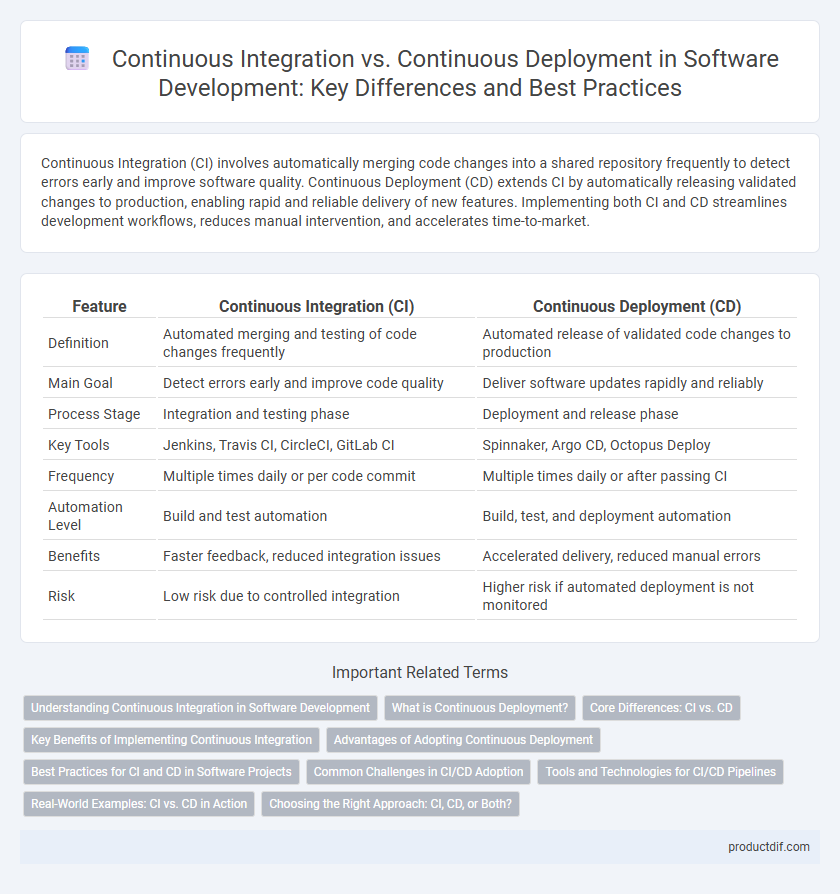Continuous Integration (CI) involves automatically merging code changes into a shared repository frequently to detect errors early and improve software quality. Continuous Deployment (CD) extends CI by automatically releasing validated changes to production, enabling rapid and reliable delivery of new features. Implementing both CI and CD streamlines development workflows, reduces manual intervention, and accelerates time-to-market.
Table of Comparison
| Feature | Continuous Integration (CI) | Continuous Deployment (CD) |
|---|---|---|
| Definition | Automated merging and testing of code changes frequently | Automated release of validated code changes to production |
| Main Goal | Detect errors early and improve code quality | Deliver software updates rapidly and reliably |
| Process Stage | Integration and testing phase | Deployment and release phase |
| Key Tools | Jenkins, Travis CI, CircleCI, GitLab CI | Spinnaker, Argo CD, Octopus Deploy |
| Frequency | Multiple times daily or per code commit | Multiple times daily or after passing CI |
| Automation Level | Build and test automation | Build, test, and deployment automation |
| Benefits | Faster feedback, reduced integration issues | Accelerated delivery, reduced manual errors |
| Risk | Low risk due to controlled integration | Higher risk if automated deployment is not monitored |
Understanding Continuous Integration in Software Development
Continuous Integration (CI) in software development is a practice where developers frequently merge code changes into a shared repository, triggering automated builds and tests to detect integration issues early. CI enhances code quality and accelerates development cycles by ensuring that new code integrates smoothly with the existing codebase. Tools like Jenkins, Travis CI, and CircleCI are commonly used to automate the CI process, enabling faster feedback and reducing the risk of bugs.
What is Continuous Deployment?
Continuous Deployment is an advanced software development practice where code changes are automatically released to production after passing automated tests, eliminating manual intervention. This approach accelerates delivery cycles, enhances product reliability, and supports rapid feedback from users. Key tools enabling Continuous Deployment include Jenkins, GitLab CI/CD, and CircleCI, which streamline the integration and deployment pipeline.
Core Differences: CI vs. CD
Continuous Integration (CI) emphasizes the frequent merging of code changes into a shared repository with automated testing to detect errors early, ensuring code quality and stability. Continuous Deployment (CD) extends this process by automating the release of validated code to production environments, enabling rapid and reliable software delivery. The core difference lies in CI focusing on integration and testing, while CD automates the deployment pipeline for continuous software release.
Key Benefits of Implementing Continuous Integration
Continuous Integration (CI) enhances code quality by automatically merging and testing changes, reducing integration issues and bug occurrence. It accelerates development cycles through early error detection and consistent feedback loops, enabling teams to deliver features rapidly. Implementing CI promotes collaboration among developers, streamlining workflows and improving overall software reliability.
Advantages of Adopting Continuous Deployment
Continuous Deployment accelerates software delivery by automatically releasing every code change that passes automated tests, reducing time-to-market and minimizing manual intervention. This practice enhances product reliability and customer satisfaction through frequent, incremental updates that allow quick detection and resolution of defects. Organizations adopting Continuous Deployment benefit from seamless integration with Continuous Integration pipelines, enabling faster feedback loops and improved development efficiency.
Best Practices for CI and CD in Software Projects
Implementing automated testing and frequent code commits are essential best practices for Continuous Integration (CI) to ensure early detection of defects and maintain code quality. For Continuous Deployment (CD), establishing a robust automated release pipeline with clear rollback strategies minimizes downtime and accelerates delivery. Both CI and CD benefit from maintaining comprehensive documentation and monitoring to enhance transparency and reliability throughout the software development lifecycle.
Common Challenges in CI/CD Adoption
Common challenges in CI/CD adoption include integrating diverse tools and technologies across development and operations teams. Ensuring consistent environment configurations and managing complex dependency chains often lead to pipeline failures and delays. Moreover, cultural resistance to frequent automated deployments and inadequate test automation coverage hinder seamless continuous integration and continuous deployment processes.
Tools and Technologies for CI/CD Pipelines
Jenkins, GitLab CI, and CircleCI are prominent tools for Continuous Integration that automate code validation and testing within CI/CD pipelines. For Continuous Deployment, technologies like Spinnaker, Argo CD, and Octopus Deploy streamline automated release management and environment-specific deployments. Container orchestration platforms such as Kubernetes integrate with these tools to manage scalable deployment processes effectively.
Real-World Examples: CI vs. CD in Action
Continuous Integration (CI) is exemplified by companies like Netflix, which integrates code changes frequently to detect defects early and maintain software quality. Continuous Deployment (CD) is demonstrated by Amazon, deploying code automatically to production multiple times a day, enabling rapid feature delivery and quick bug fixes. This real-world contrast highlights CI's role in early error detection versus CD's emphasis on automated, rapid release cycles.
Choosing the Right Approach: CI, CD, or Both?
Choosing between Continuous Integration (CI) and Continuous Deployment (CD) depends on your team's development speed, risk tolerance, and project complexity. CI emphasizes frequent code integration and automated testing to detect issues early, while CD automates the release process to deliver features rapidly and consistently. Integrating both CI and CD streamlines development workflows, enabling faster feedback loops, higher code quality, and accelerated delivery cycles tailored to modern agile and DevOps practices.
Continuous Integration vs Continuous Deployment Infographic

 productdif.com
productdif.com